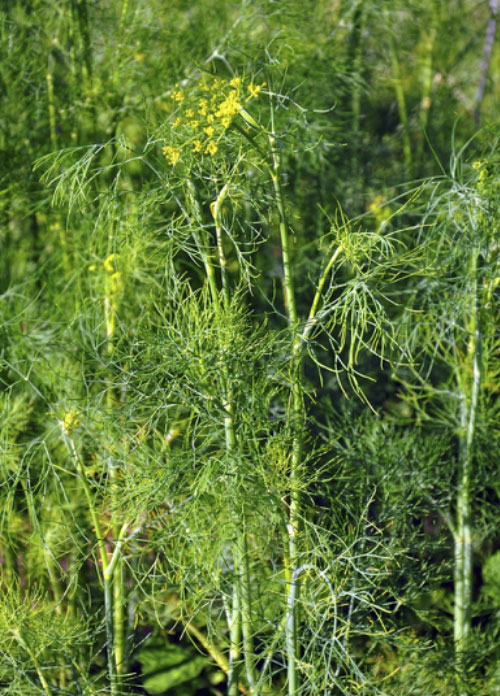Dill
Dill is an aromatic herb, which is often associated with pickles but which has many culinary and medicinal uses around the world.
Scientific Name: Anethum graveolens
Common Name: Dill
Plant Family: Apiaceae (Umbellifers)
Etymology:
Anethum is thought to come from the ancient Greek word “to burn,” which could refer to the strong smell of the seeds. This name can also be interpreted as a combination of ano and theo, which together translate to “upwards I run,” relating to dill's growing habits. The species name, graveolens, comes from Latin and means “strongly smelling.”
The common name reportedly comes from the Norse word dilla, which means to lull or sooth. It may also come from the German dolde, meaning umbel, referring to the umbel shape of the flowers.
Traditional Uses
Native to Asia and the Mediterranean, dill has been widely used for thousands of years. One of the earliest records of dill as a medicinal herb is from Egypt, and there is evidence that Babylonians were growing dill in 3,000 B.C.E. Ancient Greeks also used dill for many purposes including medicinal, as a wine ingredient and as a scented oil.
There is a long history of the medicinal use of dill. It is effective for a wide range digestive problems. It can be used as an infusion or by eating seeds whole. It can also be used as part as a cough and cold remedy. Dill may also help to increase milk production for nursing mothers.
Edible Parts
Leaves, flowers, stems and seeds.
Gathering and Using
The best time to gather leaves is right around the time that the flowers are first open. Leaves may be dried or frozen for later use but taste best fresh. Leaves lose flavor if cooked, so are best used raw or added just before dishes are finished cooking.
Dill seeds are commonly used in the making of pickles. They can also be used to flavor many other dishes including fish, vegetables, breads, herb butters. Dill seed can also be used to make teas, as well as in vinegars and sauerkraut. Dill has numerous different uses in different cultures around the world.
Permaculture Functions and Considerations
Good companion plant for corn, cabbage, lettuce and onions. Should not be grown to maturity near carrots as it inhibits their growth. Dill and coriander planted together can serve as good pest control. Aromatic, attracts many insects.
Habitat
Dill likes full sun and needs adequate water but well drained soil. Dill may bolt during dry spells. Dill is native to Asia and the Mediterranean but has been grown in Europe and the United States for so long that it has naturalized to their climates.
How to Identify
Dill can grow to between 3 and 5 feet in height and has slender stems and alternate leaves, which are very narrow and divide into three or four sections on each stem. The yellow flowers develop into an umbel shape.

https://www.gardeningknowhow.com/edible/ 1
Wildlife Support
Attracts many beneficial insects including bees, wasps, lacewings, tachinid flies, hover flies and lady beetles. It is also a larval plant for the black swallowtail butterfly.
Additional Information
In some cultures, dill was believed to provide protection from witchcraft. Charms were often made from dill springs and hung around the house or on clothing. Dill was also thought to make love potions more effective.
Sources
-
Anethum graveolens. (n.d.). Online Virtual Flora of Wisconsin.
-
Anethum graveolens - Plant Finder. (n.d.). Missouri Botanical Garden.
-
Anethum graveolens Dill. (n.d.). PFAF Plant Database.
-
Anethum graveolens L. (n.d.). USDA Plants Database.
-
Baessler, L. (n.d.). Dill plant types: What are some different varieties of dill. Gardening Know How. Retrieved February 27, 2022, from https://www.gardeningknowhow.com/edible/herbs/dill/dill-plant-types.htm
-
Dill. (2021). In Drugs and Lactation Database (LactMed). National Library of Medicine (US).
-
Dill, Anthum graveolens L. (n.d). Native Plants and Ecosystem Services.
-
Jana S, Shekhawat GS. Anethum graveolens: An Indian traditional medicinal herb and spice. Pharmacogn Rev. 2010;4(8):179-184. doi:10.4103/0973-7847.70915
-
Katzer, G. (n.d.). Spice Pages: Dill Seeds and Dill Weed (Anethum graveolens). Gernot Katzers Spice Pages.
-
Wright, J. (n.d.) The herb society of america's essential guide to dill. The Herb Society of America.